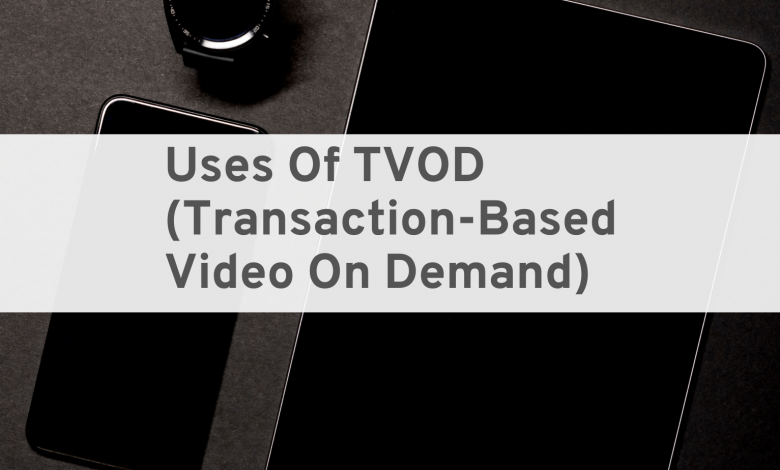Uses Of TVOD (Transaction-Based Video On Demand)

Many video creators have this question in mind when starting a video streaming business, which monetization model will be suitable for my business. In this blog, we will talk about a Transaction-based video-on-demand model and its uses in various sectors.
In TVOD, users can buy a video or video series to access it for an entire lifetime or download it for offline viewing. They are also another option where users can view the video content for particular hours or fixed periods of time at a lesser price. Viewers buy the license for the content from the platform owner for a fixed time period or an entire lifetime based on a purchase. TVOD is ideal when a small audience group is willing to pay for watching premium video content.
TVOD pulls out more income per user and it is much suitable for differentiated content that attracts a particular audience group. In Apple iTunes and Google play TVOD model use the Electronic sell-through method in which videos are licensed and downloaded for offline viewing. On other platforms, the TVOD model is also considered Download to rent where video can be accessed for a certain time. One advantage of using TVOD model is users don’t need to pay again and again like SVOD model to access the content.
Revenue in Pay per view segment is expected to reach $9303 m at the end of 2021. The number of users in TVOD segment is expected to reach 871 m by 2025. People prefer the pay-per-view option for sports events as the TVOD platform is used to watch sports videos. TVOD works well for new entertainment content. Viewers in the US spent alone $2 Billion to purchase video content in apple iTunes and Amazon prime.
TVOD for Entertainment Content
Suppose there is a new movie or entertainment content from the famous director or hero and distributor searching for a new channel to release. Then TVOD is the best option for monetizing video content. It will urge people to buy the premium content to watch.TVOD is the best choice to make more revenue from a single video and helps in generating more revenue in a shorter period.
TVOD is the best model for making most of the money from a single video. In the electronic sell-through method, iTunes is the largest platform where it rents videos for the user around $4 and completes the purchase of the video for around $10. In contrast, an SVOD platform like Netflix charges 10$ for access to entire video content. With TVOD Apple iTunes generates $10 with two video sales. SO if you have a single video Content or video series it’s better to choose the TVOD model.
It would be of great value for people on giving highly rated video content on TVOD which is not available on any SVOD platform. When buying digital content, users buy a restricted license only for viewing and they don’t completely own the content.DRM is necessary to implement a license. It prevents the user from sharing content with other people and prevents them from making illegal copies.
TVOD for Elearning
TVOD is suitable for online education. The Byjus eLearning platform followed the TVOD model generated $40 million in revenue. Coursera most popular online education platform valued at $800 million also filled TVOD model. Udemy being another education website follows the Transaction based method and students need to purchase to access the video for an entire lifetime for a one-time payment fee.
Educators add value to potential learners through online teaching. Students who are all satisfied with teaching will come again to learn more. This has helped students to score marks in examinations or people to gain new skills or knowledge. For the Elearning platform, the necessary timeline needs to be fixed so that learners remain focused to achieve the goal. There should also be additional elements like quizzes and assignments so that users can test themselves and make sure that they are gaining knowledge or not.
Online fitness instructors and yoga teachers release videos on a transaction-based model where they charge around $10 on average to access the video content for an entire lifetime. Gym instructors and yoga teachers starting online platforms have taken a huge hit because many people have started doing home workouts by seeing videos on the screen. People prefer home workouts rather than hitting the gym during this pandemic situation. Videos content may be of health tips, hardcore workouts or cardio exercises etc.
In TVOD, people have to pay higher up-front fees to access the content for an entire lifetime, whereas in SVOD, people can pay a smaller amount monthly to access the content. The biggest challenge for TVOD is customer retention. It needs a lot of marketing effort to retain existing and new customers. The greatest advantage for TVOD is with a small number of users, and the small number of videos Transaction based methods can pull out more money from a single user. You will not have customers paying money for the same video content a second time. So there are few repeat transactions, and it leads to low revenue stability.
Conclusion
Video Content monetized based on the Transactional based model(TVOD) guarantees revenue generation in a shorter period. TVOD models are used in various industries like the fitness industry as well. If you are planning to run a video streaming business, then the TVOD model is the right choice to keep in mind as many people will only keep buying online video content to watch in the future.




